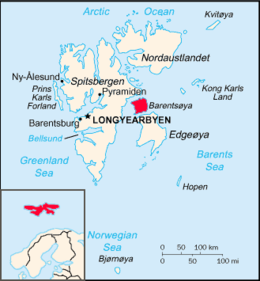Barentsøya
 |
|
| Geography | |
|---|---|
| Location | Arctic Ocean |
| Coordinates | 78°25′N 21°27′E / 78.417°N 21.450°ECoordinates: 78°25′N 21°27′E / 78.417°N 21.450°E |
| Archipelago | Svalbard |
| Area | 1,288 km2 (497 sq mi) 558 km2 (215 sq mi) glaciated. |
| Coastline | 205 km (127.4 mi) |
| Highest elevation | 590 m (1,940 ft) |
| Highest point | Schweinfurthberget |
| Administration | |
|
Norway
|
|
| Demographics | |
| Population | 0 |
Barentsøya, sometimes anglicized as Barents Island, is an island in the Svalbard archipelago of Norway, lying between Edgeøya and Spitsbergen. Barents Island has no permanent human inhabitants. Named for the Dutch explorer Willem Barents (who actually never sighted the island), it is a part of Søraust-Svalbard Nature Reserve.
Barentsøya is an Arctic island. Around 43 per cent of its area of 1,288 square kilometres (497 sq mi) is glaciated. To the north, in the sound between Barentsøya and Spitsbergen, lies the island of Kükenthaløya. To the south, the sound separating Barents Island from Edgeøya is Freemansundet.
In geologic time much of the surface rock has been eroded by glaciation. The entire area is visited by polar bears, who have a recognisable genetic differentiation specialised to the Barents Sea region. At Dørstubukta there is also a large nesting mainly used by kittiwakes.
Barentsøya has an approximately square shape, with maximum lengths and widths of about fifty kilometers, and an area of 1,288 km2 (497 sq mi). A significant part of the island, more than 500 km2 (190 sq mi), is glaciated. The ice cap of Barentsjøkulen covers a large part of the island, with the largest offsprings Besselsbreen (north), Duckwitzbreen (west), Freemanbreen (south), and Hübnerbreen (southeast). Barentsjøkulen has the two large ice domes of Peer Gyntslottet and Solveigdomen. The mountain of Schweinfurthberget is a nunatak of Barentsjøkulen.
...
Wikipedia
